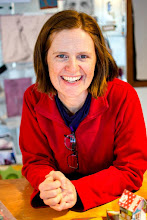Last spring semester, I took a printmaking class at the university. I wanted to take it because I never could quite understand it. Prints, I mean. I'd seen them in museums and wondered--how is that done? What is the process? What about it is artful? I'll admit that I didn't think printmaking was all that.
Now that I've spent 16 weeks learning it, well, I definitely UNDERSTAND it. More than that, I think it is pretty amazing.
So why might I title this post Tedium?
 |
| Preparing the zinc plate for intaglio means beveling the edges with a file, polishing them, and taking off the protective plastic layer. (Snacks are always close by.) |
It has something to do with the fact that this was the hardest studio art class I've ever taken. It's not that the techniques were all that hard, although because I'd never done anything like it before, it was actually harder than usual, especially to attain the standard I'm used to achieving. More than anything, it was the challenge of the process.
This is a post not so much about what I learned about printmaking, but what I learned about myself because of printmaking.
The first technique we learned was called dry point. After you prepare the zinc plate, you take an engraving tool, a scraper, and other mark-making tools to "draw" a design straight onto the metal.
 |
| This image was inspired by the 40th birthday party I'd just had, where several of my friends brought tons of delicious things and lined up the crock pots all in a row. |
Like I said, this whole concept of art-making was completely new to me, so preparing the plate and drawing a backwards image with a metal tool went pretty slow. It was taxing on the body (drawing into metal doesn't have the same ease of flow as drawing on paper, no matter the tool!). The studio was always loud with everyone scraping on their plates and air vents on all the time. There was metal dust and the smells of motor oil and India ink.
Yep, this is the semester that I learned how freaking sensitive I am. In fact, I found myself seeking comfort and constantly second-guessing myself.
Speaking of smells, our second technique turned out to be even smellier: hard ground! Coat the plate in an asphalt-beeswax mix and then scrape away the tar-like coating to reveal the part you'd like to be eaten away in acid.
It wasn't until the third technique that I finally saw a place for me in all this sharpness and hardness and chemicals and noise: soft ground. Finally, a nod to softness and nuanced texture!
I made this texture collage in my studio at home, talking on the phone with a friend for part of the time and with my speakers playing Amazon Prime's "Liquid Mind" station (yep) the other part of the time.
Instead on focusing on the visual aesthetic of color and print, I looked at all my materials solely for their textural components. I saw my art room completely anew, totally fresh.
With this technique you press your design into a softer wax coating onto the plate, then let the acid do its work!
To offer more control in the outcome of the final print, you can use multiple techniques. You can see here that I wanted to block the acid in one spot, so I used hard ground.
Here's the plate, with the wax and hard ground washed off, and all inked-up for printing:
And the print result. Pretty cool.
Our final intaglio technique was aquatint. For this one, you have to think backwards, working from light to dark, and it offers a way to do value and tone. I actually like this technique very much on a hypothetical level. I really enjoy challenging thinking processes in art.
Yet another toxic thing was added to my life for this: resin dust. By now, I had to wear a whole uniform while working in the studio. I was starting to feel like Darth Vader.
The aquatint plate, and the print, below:
 |
| All the Letters I Never Write, aquatint print, Image area 11¾” x 18”, Paper size 18½” x 24½”, edition of 2 |
Here's a photo of some of my printmaking classmates/friends, who loved talking about art and were smiley and encouraging along the way: Mac, Taylor, Zach, and Erin.
I said before that I find printmaking to be truly amazing. I do. I am really impressed.
I am so grateful to have learned how to do it. My art context has expanded exponentially. Now, I UNDERSTAND printmaking. And I have so much respect for the artists who love it and focus on it, and strive to be excellent at it.
And yet for me, printmaking was simply not soft enough, not quiet enough, and too darn smelly. There was a "this takes forever" component in the process that wasn't satisfying enough for me. There wasn't enough instantly-gratifying progress (no matter how small) as I proceeded through the process.
Indeed, I declared a fibers concentration this semester. Not that there isn't a certain amount of tedium in weaving or dyeing or hand stitching. It's just that for some reason, my personality and sensibilities don't mind that kind of tedium as much.
As a last hurrah* to printmaking, in case you're wondering how to get the print from the zinc plate to the paper, I made this 3:33 minute video showing the process.
*Well, there was one thing I actually really liked in printmaking (relief printing), but I'll blog about that in the next post. :)

























































